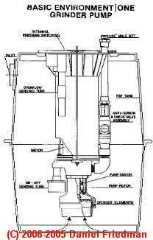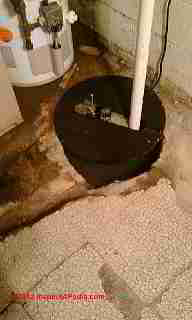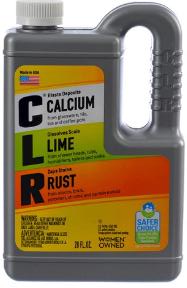 Septic & Sewage Pump FAQs
Septic & Sewage Pump FAQs
Q&A on Sewage Pumps, Septic Pumps, Effluent Pumps & Sump Pumps
- POST a QUESTION or COMMENT about buying, installing, and repairing sewage ejector pumps and pump controls and about sewage and sump pump safety
Septic pump questions & answers:
Here we answer frequently-asked questions about all types of septic system pumps.
This article series explains the differences between Septic System Pumps and Sump Pumps , Sewage Ejector Pumps, Septic Grinder Pumps, Sewage Pumping Stations, & Septic Pump Alarms. We also include definitions of types of septic system pumps; Warning of items that will clog septic pumps and grinder pumps & Warning about trip and fall and health hazards of exposed sewage ejector pumps
Advice is given for septic tank effluent or sewage pump selection and use.
InspectAPedia tolerates no conflicts of interest. We have no relationship with advertisers, products, or services discussed at this website.
Septic Pump, Sewage Grinder, Sewage Effluent Pump FAQs

Recent questions & answers about septic pump types, applications, sources, repairs, posted originally at SEPTIC SYSTEM PUMPS - topic home. Be sure to review the guidance given there.
On 2018-09-08 by (mod) - How far can a sewage pump pump with a minimum fall
Robert,
I'm not sure what you have in mind by "minimum fall" - perhaps a pipe drain slope of 1/8" per foot of horizontal run? That's not the usual limitation.
Sewage pumps will generally be rated in GPM capacity and in LIFT capacity - how high the pump can lift the wastewater or sewage. The assumption is that from the point of discharge the waste flows by gravity to a destination (sewer line or septic tank) so the horizontal distance isn't given.
Example: A Zoeller 1/2 HP Simplex sewage ejector pump has a head or lift capacity of 21 ft. maximum, noting that the GPM rate of the pump (using clean water as an example to get consistent flow rates) is going to drop off as the lift increases.
At 0-5 ft. head the pump can push 128 gpm, while if the lift height or head is 20 ft. the GPM rate falls off to just 10 gpm.
A different case is a sewage grinder pump used on a "force main" that actually pushes ground sewage over some distance. For that type of pumping system there will be both a lift capacity and a GPM flow rate table that considers vertical distance, horizontal distance, pipe diameter, pipe obstructions or bends or elbows, possibly even pipe material.
More about force mains and sewage pumping stations is at SEPTIC PUMPING STATIONS
On 2018-09-05 by Robert
How far can a sewage pump pump with a minimum fall
On 2018-07-14 by (mod) -
Truly I can't make a specific referral, not only in order to avoid a conflict of interest but because we don't even know the country and city where you live. In any case you want to work with local septic or excavator contractors who have experience with installing grinder pumps. Or you may find a plumber who can handle the excavation work.
I wouldn't start anything before getting an accurate diagnosis of what's happened to the present installation. It sounds as if the excavation and backfill may have been improper.
On 2018-07-13 by Anonymous
Question we love in county and sewer company made builder put in grinder pump he put it in front yard in five years since putting in have costed ten thousand dollars in repairs builder has went out of business and needs to be replace ground around it sinking in any suggestions my sister has limited income since husband passed away any suggestions on people that can help her
On 2018-06-19 by (mod) - using CLR toilet bowl stain remover on a sewage effluent pump
 Greg,
Greg,
Your question: effect of using CLR toilet bowl stain remover on a sewage effluent pump or a septic grinder pump is an excellent one.
Some authorities warn that acids or other chemicals might harm a septic system (I agree), and some chemicals may harm the seals in the grinder pump system.
However I pose that occasional use of a toilet stain remover (often including acids), used as directed, will be diluted enough to avoid such harm. You can reduce the risk of grinder or effluent pump damage further by additional dilution of the acid-based cleaner: try 2 or three additional flushes to dilute and then remove the acidic cleaner from the grinder pump reservoir.
Instructions from CLR for using this product to clean a severely-stained toilet bowl, the company suggests using 5-6 oz of CLR into a toilet bowl that has been emptied of water, then scrubbing the bowl with the solution.
At that level of usage and when further diluted by water as the toilet is flushed, even in the first flush the 6 oz. of solution (hazardous acidic) is diluted in 1-2 gallons of water or more (depending on toilet design and flush quantity).
In even a single gallon flush you are diluting the solution by 6:128 and subsequent flushes further dilute the solution.
In three flushes or 3 gallons total, you have diluted the original acidic CLR cleaner to 1% of its original strength. Even without knowing the actual level of acidity of the product as sold in the container, this is likely to be so dilute as to be harmless to the pump.
The product, used as directed, is in my opinion harmless to a septic grinder pump as well as harmless to a septic system.
For other readers, CLR is a calcium, lime, rust remover "from glassware, tile and coffee pots. It removes lime scale from shower heads, tubs, humidifiers, toilets and sinks. This CLR cleaner also removes rust stains from stucco, brick, porcelain and chrome." contains the following chemicals:
Water CAS 7732-18-5,
Lactic Acid CAS 79-33-4, classified by OSHA as hazardous
Gluconic Acid CAS 526-95-4, classified by OSHA as hazardous
Lauramine Oxide CAS 1643-20-5, classified by OSHA as hazardous
Tripropylene Glycol N-Butyl Ether CAS 55934-93-5,
Blue 1 CAS 3844-45-9,
Yellow 5 CAS 1934-21-0.
CLR is produced by Jelmar, 5550 W. Touhy Ave. Skokie, IL 60077 USA
See the MSDS for CLR at inspectapedia.com/hazmat/CLR-Calcium-Lime-Rust-Remover-MSDS.pdf
The MSDS for CLR includes this
Emergency Overview: WARNING: EYE IRRITATANT. GHS Toxicity Category 2A Causes eye irritation and possible SKIN IRRITATANT GHS Category 3 – on sensitive skin.
DO NOT get in eyes, on skin or clothing. DO NOT mix with bleach or other household chemicals as harmful fumes may result. DO NOT ingest. DO NOT breathe vapor or mist.
Use in well ventilated areas. Keep container closed when not in use
Please also see TOILETS, DON'T FLUSH LIST
I will include this discussion at another article you should review: SEWAGE PUMP DAMAGE & REPAIR
On 2018-06-19 by Greg
Is the use of CLR to clean a toilet bowl safe for a septic grinder pump?
On 2017-08-25 by (mod) -
Petel,
If by "shredder pump" you refer to a sewage ejector pump motor, some pump motors are permanently-lubricated at the factory.
You should not need to add lubricant. If you do the pump must be damaged and needs repair or replacement. If you gave us the pump brand and model we could research a more-specific and detailed answer.
Please ask questions once in just one place at InspectApedia.
Thanks
On 2017-08-25 by Petel
What is the clear liquid inside my shredder pump and where can I get more?
On 2017-06-15 by Mike
Can you use heat tape on pvc discharge line from sewer ejector. If so how do you install it ??
thanx, Mike
On 2017-05-03 by (mod) - groundwater entering the septic or sewage pump tanks
Anon
I'm sorry but no pump is going to solve the problem if by "sump pump tanks" you mean sewage ejector or sewage effluent pumps that are part of a septic system - because even if you put in a pump that handled the water load, you'll flood the septic soakbed/drainfield and ruin it in short order.
If you mean you need to remove large volumes of groundwater from around a building using sump pumps, you may want a cascade of pumps and multiple pumping points as well as a suitable destination that directs the ejected water well away from the building.
But in my experience it is also worth finding out where that water's coming from: most of the time you can find and fix that problem at the roof, gutters, or surface drainage around a building.
On 2017-05-02 by Anonymous
which pump would be best for a situation where we get a LOT of groundwater coming into our two sump pump tanks? The geology under our foundation seems to be a collection point for runoff after large rains.
A normal sump pump runs nearly continuously for up to two days after a big rain. We are NOT planning to pump sewage but would a sewage ejector pump do a better job for high volumes of water?
On 2017-02-15 by (mod) - A lightning strike or a failed start capacitor can cause a motor to run backwards
A lightning strike or a failed start capacitor can cause a motor to run backwards - search InspectApedia for MOTOR RUNS BACKWARDS for details.
On 2017-02-12 by abe
why is my sewer pump going backwards all of a sudden. was working fine.
On 2017-02-15 by (mod) - cause of septic pump motor running backwards
A lightning strike or a failed start capacitor can cause a motor to run backwards - search InspectApedia for MOTOR RUNS BACKWARDS for details.
On 2017-02-12 by abe
why is my sewer pump going backwards all of a sudden. was working fine.
On 2017-01-17 by (mod) - ejector pump to sewer doesn't mean there was never a septic tank at a property
Jan: you are describing an ejector pump that lifts waste to a public sewer system.
You can report, if it's true, that since you've owned the home it has always been connected to a public sewer.
However the buyer wants to know, and you want to know for safety and liability reasons, if your home ever had a septic tank or cesspool. That may be determined by age of the home, location, local building department records.
Also see SEPTIC or SEWER CONNECTION?
On 2017-01-17 by Jan
I am completing forms, getting ready to sell my house. It asked:
Has any septic tank or cesspool on the property ever been professionally serviced? Please clarify if there is a "cesspool" as part of my sump pump system. I have a sump pump in my basement because of the low elevation relative to the public sewer line that runs in front of my house.
On 2016-11-23 by (mod) - where is the septic pump float
Angela:
perhaps, but float and pump controls vary, I can't know from just a brief e-text.
On 2016-11-23 by angela
I don’t see the floater or the sump pump. Could it have fallen into the tank
On 2016-11-11 by (mod) - test button on pumping station
Start by confirming that the pump and controls have power.
Then let me know the brand and model of the equipment so that you or I can find the septic pump control instruction manual, since switches and controls and features vary by manufacturere and model.
On 2016-11-11 by Shelly Plemons
When I push the test button on my septic tank pumping station the light does not come on nor does the quick alarm sound go off.
I am assuming this means that there is a problem with the pump not getting power. Any advice on how to go about testing to try to figure out what would cause this?
On 2016-08-23 by (mod) - how powerful a septic pump is required
I don't have the whole picture anon. But if your more distant bath is draining by gravity into the sewage ejector pump then the pump is working the same and doing the same for all fixtures that it serves: it doesn't know where the waste is originating.
So if the remote bath doesn't drain I suspect that the problem is in the piping between bath and pump or the slope is inadequate or the pipe's clogged.
On 2016-08-23 by Anonymous
Dose my pump for septic have to be more powerful if my one bathroom is on the other side of the house...the pump works great for my washer from my other bathroom and kitchen ..but it won't won't drain from the far bathroom.
...
Continue reading at SEPTIC SYSTEM PUMPS or select a topic from the closely-related articles below, or see the complete ARTICLE INDEX.
Or see these
Septic Pump Articles
- SEWAGE EJECTOR / GRINDER PUMPS - home
- DISPOSABLE WET WIPE CLOGS
- FREE-STANDING GRINDER PUMPS
- SEWAGE TREATMENT PLANTS, RESIDENTIAL
- SEPTIC SYSTEM PUMPS
- SEPTIC PUMP ALARM SYSTEMS
- SEPTIC PUMP BUYERS GUIDE & MANUALS
- SEPTIC PUMP DUPLEX DESIGNS
- SEPTIC PUMP INSPECTION & MAINTENANCE
- SEPTIC PUMP INSTALLATION
- SEWAGE PUMP DAMAGE & REPAIR
- SEWAGE PUMP INTERMITTENT CYCLING
- SEWAGE PUMPING STATIONS
- SEWAGE PUMP BUYERS GUIDE & MANUALS
- SEWAGE PUMP DAMAGE & REPAIR
- SEWAGE PUMP ODORS
- SEWAGE ODOR SOURCE LOCATION
- SEWAGE PUMPING STATIONS
- WAXY BIOFILM SLIME CLOGS in DRAINS & PUMPS
- SUMP PUMPS
Suggested citation for this web page
SEPTIC PUMP FAQs-2 at InspectApedia.com - online encyclopedia of building & environmental inspection, testing, diagnosis, repair, & problem prevention advice.
Or see this
INDEX to RELATED ARTICLES: ARTICLE INDEX to SEPTIC SYSTEMS
Or use the SEARCH BOX found below to Ask a Question or Search InspectApedia
Ask a Question or Search InspectApedia
Try the search box just below, or if you prefer, post a question or comment in the Comments box below and we will respond promptly.
Search the InspectApedia website
Note: appearance of your Comment below may be delayed: if your comment contains an image, photograph, web link, or text that looks to the software as if it might be a web link, your posting will appear after it has been approved by a moderator. Apologies for the delay.
Only one image can be added per comment but you can post as many comments, and therefore images, as you like.
You will not receive a notification when a response to your question has been posted.
Please bookmark this page to make it easy for you to check back for our response.
Our Comment Box is provided by Countable Web Productions countable.ca
Citations & References
In addition to any citations in the article above, a full list is available on request.
- .../li>
- Our recommended books about building & mechanical systems design, inspection, problem diagnosis, and repair, and about indoor environment and IAQ testing, diagnosis, and cleanup are at the InspectAPedia Bookstore. Also see our Book Reviews - InspectAPedia.
- In addition to citations & references found in this article, see the research citations given at the end of the related articles found at our suggested
CONTINUE READING or RECOMMENDED ARTICLES.
- Carson, Dunlop & Associates Ltd., 120 Carlton Street Suite 407, Toronto ON M5A 4K2. Tel: (416) 964-9415 1-800-268-7070 Email: info@carsondunlop.com. Alan Carson is a past president of ASHI, the American Society of Home Inspectors.
Thanks to Alan Carson and Bob Dunlop, for permission for InspectAPedia to use text excerpts from The HOME REFERENCE BOOK - the Encyclopedia of Homes and to use illustrations from The ILLUSTRATED HOME .
Carson Dunlop Associates provides extensive home inspection education and report writing material. In gratitude we provide links to tsome Carson Dunlop Associates products and services.

